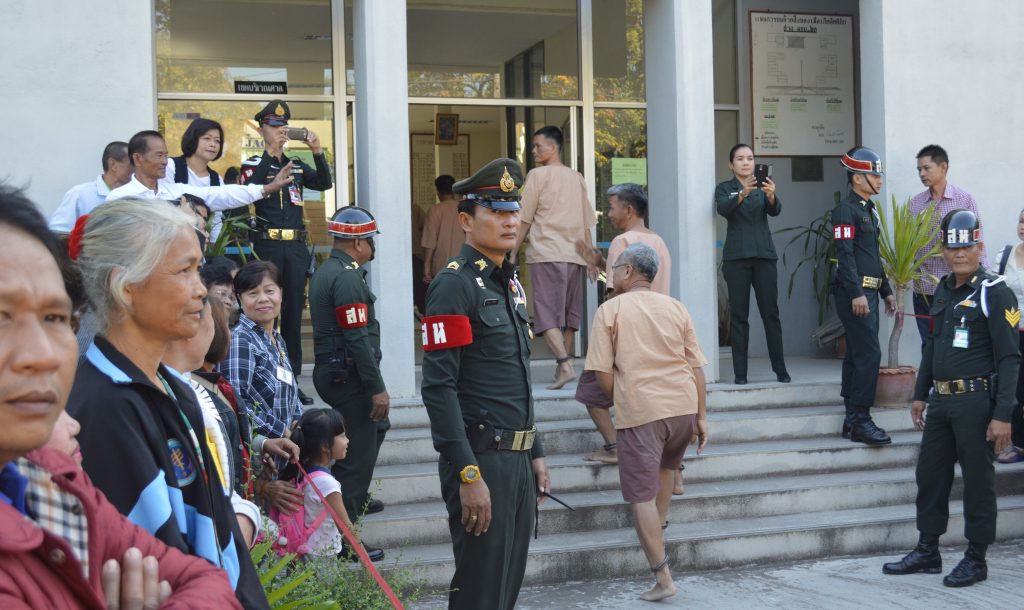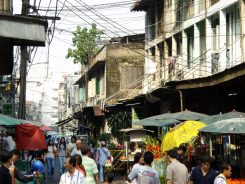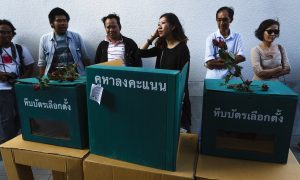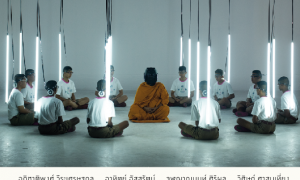เราจะทำความฝันให้เป็นจริง
หรืออยากทำความจริงให้เป็นฝัน
เราตื่นอยู่ในโลกใบเดียวกัน
หรือหลับฝันในโลกคนละใบ
—กฤช เหลือลมัย, 2014
[Are we making reality out of our dreams—Or do we want to make dreams out of reality?
Are we awake on the same planet—
Or asleep and dreaming on separate ones?
—Krit Luea-lamai, 2014]
This article points out key parallels between two seemingly unrelated media spectacles—both dubbed the “Khon Kaen Model”—and proposes that together they tell an exemplary story of the two faces of Thailand’s current military regime. The two Khon Kaen Models effectively model the junta’s anti-politics machine: the junta’s power expands through suppressing “political” activity on one hand and endorsing “apolitical” development projects on the other.
Introduction
For about a year, news outlets in Thailand have been shining the spotlight of hope on Khon Kaen City, a provincial capital in the Northeast. The city is pushing a transit-oriented development initiative that breaks away from the center-periphery model which has long characterised the Thai provinces. The project boasts a Light Rail Transit (LRT) system, also referred to as a SkyTrain, that doesn’t depend on Bangkok for funding, construction or management. This initiative has been dubbed the Khon Kaen Model.
In May 2018, New Mandala followed suit, running the bilingual story, “The Khon Kaen Model: eschewing Bangkok-centric development [ขอนแก่นโมเดล: ไม่ยอมซ้ำรอยอนาคตแบบ “กทม.”]”, written by the academic Pechladda Pechpakdee.
In October 2018, the LRT received the crucial approval of the central government, meaning that the local “public-private collaboration” between big businesses and several municipalities in the greater Khon Kaen City area won the right to execute the project themselves. So the march continues towards victory for the people of Khon Kaen, or so it seems.
There is one major problem though. “Khon Kaen Model” is also the namesake of a terrorism case currently on trial in Khon Kaen military court (as well as the namesake of another terrorist plot that emerged a year later dubbed Khon Kaen Model Part Two). The day after the latest coup d’etat on 22 May 2014, all mainstream media outlets were flooded with the headline Khon Kaen Model with images of seized weapons and stories of a handful of middle-aged red shirt “terrorists” plotting to take down the junta in a hotel on the outskirts of Khon Kaen City.

In all, 26 people were charged as a result of the alleged plot. But not until 28 October 2016 —more than two years later—did the trial officially start and the first witness from the military prosecutor’s side called. By April 2018, almost four years after the case first made the news cycle, only 6 witnesses out of 90 on the prosecutor’s side have made an appearance in the hearing. Needless to say, the trial will continue long after Khon Kaen finishes its LRT construction.
Only the English version of Pechladda’s New Mandala article provided a disclaimer on the multiple meanings of the titular term. The disambiguation paragraph goes as follows:
The phrase “Khon Kaen Model” connotes two rather disparate meanings. The first is deeply political. In 2014, the National Council for Peace and Order (NCPO) used “the Khon Kaen Model” to refer to a group in the province allegedly amassing forces and weapons to terrorise the citizenry. The group was arrested on 23 May 2014. But local administrators, academics and entrepreneurs refer to the Khon Kaen Model to capture the northeastern city’s unique private sector-driven approach to infrastructure development. The province of Khon Kaen is home to a first-class secondary city: situated in the heart of Isaan, connected to other parts of Thailand via high-speed railway, and on its way to being connected internationally via an airport. Khon Kaen also falls in both the East–West Economic Corridor and a sub-section of the North–South Economic Corridor.
The rest of the article in either language dealt exclusively with Khon Kaen’s infrastructure development.
Whether this disparity in the two versions was due to the author or the editor, the absence of this explanation in Thai is symptomatic of an all-too-common phenomenon. In my cursory review of about a dozen Thai-language articles on Khon Kaen’s local development initiative, not one article has a disambiguation clause for the reader, let alone treats the two Models in comparison. In fact, Pechladda’s direct comparison quoted above is the first I have come across.
[Editor’s note: To clarify, the omission of mention of the terrorism case in the Thai-language version of the article was entirely my own decision with approval from the author. Originally, Pechladda submitted two versions of the piece. The first was a broad summary of the LRT project while the second was a more detailed write-up—this was the version ultimately published on New Mandala. In the broad summary submitted by Pechladda, she had included the following paragraph describing the political meaning of Khon Kaen Model, on which the English disambiguation was based: ขอนแก่นโมเดล แท้จริงแล้วมีความหมาย 2นัยยะ นัยยะทางการเมืองนั้นขอนแก่นโมเดลเป็นชื่อ ที่แสลงหูของภาครัฐส่วนกลาง โดยเฉพาะรัฐบาล คสช. โดยฝ่าฝืนประกาศ คสช. ที่ 7/2557 กล่าวคือ ปฏิบัติการ “ขอนแก่นโมเดล” เป็นชื่อที่เจ้าหน้าที่รัฐเรียกคนกลุ่มหนึ่งที่จับกุมได้ในจังหวัดขอนแก่น โดยเจ้าหน้าที่เชื่อว่า ผู้ต้องหาตระเตรียมการโดยสะสมกำลังพล อาวุธ จัดหาหรือรวบรวมทรัพย์สินเพื่อดำเนินการตามแผนการ เพื่อสร้างความปั่นป่วนเพื่อให้เกิดความหวาดกลัวในหมู่ประชาชนและเพื่อก่อการร้าย โดยมีการจับกุมได้ที่ อ.เมือง จ.ขอนแก่น ในวันที่ 23 พฤษภาคม 2557. Having put aside the first version of the piece, I neglected to copy-and-paste the above paragraph from the first to the second version, assuming that the phrase’s double-meaning would be readily apparent to Thai readers but not English readers. In this respect, the critique of the omission should be aimed at my editorial choices more so than Pechladda’s writing!]
It’s as if the first Khon Kaen Model had only existed in a parallel universe. A preliminary Google search of the term in Thai mostly yields stories on the local development hype, though a news article on 21 August 2018 managed to burst through with the headline “Khon Kaen Model-Red Isan in Agony! Neglectful ‘UDD-Pheu Thai Leaders’ Exposed”.
A closer look at Pechladda’s paragraph reveals a contrast set up between the two Khon Kaen Models. One is used by the military junta, the other by local administrators, academics, and entrepreneurs. One is deeply political, the other one not so much. One is about “a group in the province”, the other a larger local network. There is apparently no relationship between the two Khon Kaen Models, and the disambiguation is there just to clarify that this isn’t about that other thing.
The two meanings, however, aren’t necessarily “disparate”: things so unlike that there is no basis for their comparison. We may draw several comparisons between the two. Doing so can assist in revealing the bare foundations of propaganda and power in contemporary Thailand under military rule.
Parallel #1: Both appear as loanwords—what gets translated and what doesn’t in “model”?
Non-Thai readers might be surprised to learn that the term Khon Kaen Model has always appeared as khon kaen model in Thai. Apparently, all the term’s users—the junta, mass media, the Khon Kaen City elite—have always felt it optimal or preferable to not translate the word “model” into baep yaang or ton baep or tua baep. Usually, model suffices.
The use of the loanword model is telling. The model in Khon Kaen Model—and other such models in Thai public culture—emphasises only one sense of the English word “model”. It is an example set for others to follow, but it isn’t a representation of something (a model which aims to make something more understandable). In other words, the Khon Kaen Model is prescriptive. On one hand, the model is a 5-step plan of economic and political seizure allegedly cooked up by red-shirt rebels who seek to execute this plan in Khon Kaen and then replicate it in other provinces. On the other, the model is a paragon for autonomous local development that other medium-sized cities may follow. The model is not descriptive; it doesn’t model the workings of an actually-existing military regime or an actually-existing Khon Kaen City.
There’s a model for just about every issue in Thailand today. Poverty reduction? See the junta’s “Kalasin Happiness Model”. Marriage equality? See the civil-society-led “Amphawa Model”. Solution to smog? See the government’s “Mae Cham Model Plus”—the plus here also a loanword. This selective use of the word across the political spectrum illustrates well Thai society’s tendencies towards prescriptivism and dreams of scale—from the “correct” Thai language determined by the Royal Institute, to the principles of Sufficiency Economy “Philosophy”.
Here, the Khon Kaen City development initiative is shielded from criticism by the appearance of exemplary localism under the cloak of phrases like “the true needs and desires of the local people”.
Parallel #2: Both have been circulated (or even coined) by the military junta.
The Khon Kaen Model case defendants have always denied knowledge of the alleged terror scheme. Evidence points towards the term being coined by the junta, then passed on to media.
The Khon Kaen Model: eschewing Bangkok-centric development
ขอนแก่นโมเดล: ไม่ยอมซ้ำรอยอนาคตแบบ "กทม." Public services infrastructure in Khon Kaen is being funded and spearheaded by the Khon Kaen Think Tank (KKTT), a group of the province's 20 leading businessmen.
It is plausible that the junta had a hand in recycling the term “Khon Kaen Model” for use in a positive way. I make this speculation because another buzzword of Khon Kaen City’s local development—“Khon Kaen Smart City” —was actually given and encouraged by the soft-spoken and intellectually-curious Deputy PM Prajin Juntong. “Smart City” effectively replaced an earlier term “Khon Kaen Special City”, which expressed an aspiration for administrative autonomy.
Regardless of who actually came up with the idea of recycling “Khon Kaen Model” to refer to local development, city mayor Theerasak Theekhayupan has referred to its adoption by the junta leader as a “win” for Khon Kaen (because it shows that the Model has become an inspiration nationwide). The segment of Prayuth’s propaganda show has been archived on YouTube by the local private-sector elite Khon Kaen Think Tank itself.
The tagline of Pechladda’s article—“eschewing Bangkok-centric development” in English and “refusing to follow a Bangkok-style path to the future” in Thai—juxtaposes Khon Kaen with Bangkok, suggesting a refusal to obey and continue a historical pattern of subservience. A closer reading reveals, however, that this refusal may be better understood as strategic obedience and collusion with Bangkok authorities.
The junta’s adoption of a positive inflection to the Khon Kaen Model destroys any deceptive illusion of clear lines between “local” and “national”. In a way, claims of localism can mislead us into thinking that Khon Kaen is winning in some kind of zero-sum game against Bangkok, when in fact both national and local elites are winning—while the real losers are kept out of sight.
If the Khon Kaen City elite intended to redeploy negative discourse to subvert the power of those who came up with the term, they aren’t doing well to show that they care about redeeming the original victims of the label. Co-opting the Khon Kaen Model term does just the opposite. The red shirt defendants are forgotten and left even further behind, whether deliberately or not.
Parallel #3: Both were deliberate attempts at propaganda to generate a political effect.
The Khon Kaen Model case, only one day removed from the 2014 coup d’etat, was an obviously convenient story to legitimise military rule at a time when many were afraid there might be another round of bloodshed. No matter the truth of the case, the junta sensationalised the namesake even a year-and-a-half later in a separate incident dubbed Khon Kaen Model Part Two, belying the military government’s deliberate use of the fear fueling and being fueled by this story to secure its grip on power.
But can we similarly call the other Model propaganda? In an interview published on 3 November 2018, Khon Kaen businessman and university administrator Suradech Thaweesaengsakulthai points to the importance of maintaining media hype about the whole local development business.
ความท้าทายที่ยากที่สุด?
The most difficult challenge?
คนไม่เชื่อ
People don’t believe [it].
และเราก็ต้องมีความแน่วแน่ เพราะนั้นมันต้องทำให้เห็น และความท้อมันต้องไม่มี
And we must have resolve. Therefore it needs to be demonstrated, and there must be no discouragement.
ทำยังไงให้พวกเค้าเชื่อ มันยากมากนะ
How to make them believe, that’s a very difficult thing.
เราเรียกว่า communication เป็นเรื่องสำคัญ ค่อยๆ แจกทีละข่าว
We call [it] “communication”. An important thing. Distributing news, article by article.
มีเวทีค่อยๆ จัดกันทีละครั้ง ไปต่อหรือไม่ไปต่อ ทำให้คนยังรู้สึกยังลุ้นอยู่ด้วย
Organising [talks/panels on] stage, event by event. To go forward or not to go forward. Also keeping people hyped up [about whether it will happen or not]
Note the implicit use of the term khaaw chaek, or propaganda (used here non-pejoratively). Suradech’s casual use of the verb chaek betrays a penchant for propaganda: one-sided stories that do not seek different views, but which nevertheless regularly count as “news” in Thailand. When media outlets receive khaaw chaek from vested organisations, they often just run the pieces as they come.
Once, as a news editor, I ran a khaaw chaek story from a regional statistics organisation but changed the lead and headline to emphasise a politically significant number that struck me but which was buried in the original article. As a result, the media outlet I worked for never received khaaw chaek from the organisation ever again, despite our repeated attempts to reach out and re-enter their mailing list.
This is not to say that the Khon Kaen City elite would behave similarly; in fact, they take pride in being a city that “allows” disagreements. The point here is that when unadulterated khaaw chaek is a norm for news, much of the media hype leads ultimately to shallowness. The curious citizen is left feeling short-changed: you spent all that PR energy and money for this? What’s the actual reality?
Every time the positive buzzword Khon Kaen Model is used without comparison to its counterpart, the original usage is buried a little deeper, article by article, year by year, under yet another layer of propaganda.
Conclusion
What do we make of all these parallels?
From the viewpoint of the Khon Kaen City elite, their Khon Kaen Model is perhaps a victorious cry over the national centre’s silencing of local power. One may however see it as an unintentional silencing of another Khon Kaen Model, itself marginal to the city’s elite.
But it all goes a level even deeper—it’s not just one Khon Kaen silencing another Khon Kaen. Perhaps these two localisms result from the same monstrous machine.
In the early days of the current junta, I heard several stories about the interrogation tactics used by the authorities against detained dissidents. The military keeps a file on you and then calls you in for “attitude adjustment”, an intimidating situation with many officials facing you. Invariably, there is a mean official and a nice official, who take turns threatening and spewing lies about you, before coaxing you and expressing sympathy towards your predicament. Known as the good cop/bad cop routine, the classic interrogation tactic aims to extract information from the subject through the double face of fear and trust.
Try replacing the good cop with Deputy PM Prajin Juntong vis-à-vis the Khon Kaen City apolitical elite, and the bad cop with the military prosecutor vis-a-vis the Khon Kaen red shirt defendants. Maybe then it becomes clearer what is being extracted out of all of us in this very long interrogation.
Once rid of the smoke screen of localism, both Models appear as effects of the same anti-politics machine. This machine’s job is to pump out policy and fear-mongering propaganda, which masquerade as peace and order over “political groups” on one hand and cooptation and endorsement of “apolitical” local development on the other. The ultimate effect remains deeply and decidedly political—that of extracting obedience from the populace and securing power for the military regime.
Acknowledgements
I am grateful to Richard MacDonald, without whom I could not and would not have conducted the research. Since May 2018, Richard has steered my inquiry into the Khon Kaen Smart City initiative, given me pointers towards key people, events, and topics to attend to, and helped me think through many of my arguments here and elsewhere. Some of the research that appears in the article was undertaken in the context of a collaborative project (Department of Media & Communication, Goldsmiths, University of London and the Centre for Contemporary Social and Cultural Studies, Thammasat University) on digital inclusion/exclusion funded through the UK Newton Institutional Links scheme and the Thailand Research Fund. Further details are here.
 Facebook
Facebook  Twitter
Twitter  Soundcloud
Soundcloud  Youtube
Youtube  Rss
Rss 



